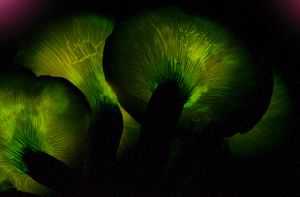Omphalotus olearius: Difference between revisions
No edit summary |
No edit summary |
||
| Line 19: | Line 19: | ||
==References== | ==References== | ||
[1] | [1] Spalding, Beatrix. "The Jack-O-Lantern Mushroom." Horticulture and Home Pest News 493.23 (2005): 111. Print. | ||
==Author== | ==Author== | ||
Page authored by | Page authored by Brett Hensrud, student of [mailto:helv0010@umn.ed Mandy Brosnahan], Instructor at the University of Minnesota-Twin Cities, MICB 3301/3303: Biology of Microorganisms. | ||
<!--Do not edit or remove this line-->[[Category:Pages edited by students of Mandy Brosnahan at the University of Minnesota-Twin Cities]] | <!--Do not edit or remove this line-->[[Category:Pages edited by students of Mandy Brosnahan at the University of Minnesota-Twin Cities]] | ||
Revision as of 00:59, 22 July 2013
Classification
Fungi; Basidiomycota; Agaricomycetes; Agaricales; Omphalotaceae
Omphalotus olearius
Description and Significance
O. olearius is a mushroom reminiscent of a chanterelle mushroom. Like the chanterelle, its fruiting bodies have an appealing taste and odor, leading many people to consume them. However, unlike the chanterelle, O. olearius contains toxic compounds which can cause severe stomach cramps, vomiting, and diarrhea. In addition, it exhibits significant bioluminescence as well, which has resulted in it becoming known as the "Jack-o-lantern" mushroom. One point of interest is that the toxic compounds produced by O. olearius have been shown to contain an anti-cancer chemical known as irofulven. Currently, the mechanism of irofulven's anti-cancer properties is not well-understood, but it appear to be unique from other anti-cancer agents. [1]
Structure, Metabolism, and Life Cycle
Interesting features of its structure; how it gains energy (how it replicates, if virus); what important molecules it produces (if any), does it have an interesting life cycle?
Ecology and Pathogenesis
Natural habitat (soil, water, commensal of humans or animals?)
If relevant, how does this organism cause disease? Human, animal, or plant hosts? Important virulence factors, as well as patient symptoms.
References
[1] Spalding, Beatrix. "The Jack-O-Lantern Mushroom." Horticulture and Home Pest News 493.23 (2005): 111. Print.
Author
Page authored by Brett Hensrud, student of Mandy Brosnahan, Instructor at the University of Minnesota-Twin Cities, MICB 3301/3303: Biology of Microorganisms.

